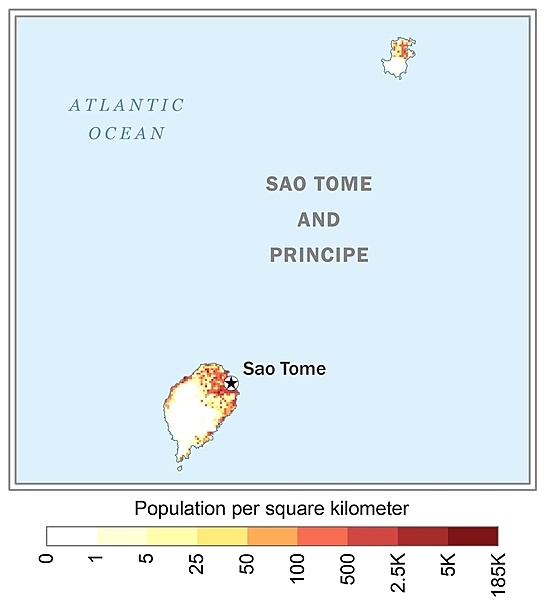
220,372 (2023 est.)
noun: Sao Tomean(s)
adjective: Sao Tomean
Mestico, Angolares (descendants of Angolan slaves), Forros (descendants of freed slaves), Servicais (contract laborers from Angola, Mozambique, and Cabo Verde), Tongas (children of servicais born on the islands), Europeans (primarily Portuguese), Asians (mostly Chinese)
Portuguese 98.4% (official), Forro 36.2%, Cabo Verdian 8.5%, French 6.8%, Angolar 6.6%, English 4.9%, Lunguie 1%, other (including sign language) 2.4%; note - shares sum to more than 100% because some respondents gave more than one answer on the census; other Portuguese-based Creoles are also spoken (2012 est.)
Catholic 55.7%, Adventist 4.1%, Assembly of God 3.4%, New Apostolic 2.9%, Mana 2.3%, Universal Kingdom of God 2%, Jehovah's Witness 1.2%, other 6.2%, none 21.2%, unspecified 1% (2012 est.)
Sao Tome and Principe’s youthful age structure – more than 60% of the population is under the age of 25 as of 2020 – and high fertility rate ensure future population growth. Although Sao Tome has a net negative international migration rate, emigration is not a sufficient safety valve to reduce already high levels of unemployment and poverty. While literacy and primary school attendance have improved in recent years, Sao Tome still struggles to improve its educational quality and to increase its secondary school completion rate. Despite some improvements in education and access to healthcare, Sao Tome and Principe has much to do to decrease its high poverty rate, create jobs, and increase its economic growth.
The population of Sao Tome and Principe descends primarily from the islands’ colonial Portuguese settlers, who first arrived in the late 15th century, and the much larger number of African slaves brought in for sugar production and the slave trade. For about 100 years after the abolition of slavery in 1876, the population was further shaped by the widespread use of imported unskilled contract laborers from Portugal’s other African colonies, who worked on coffee and cocoa plantations. In the first decades after abolition, most workers were brought from Angola under a system similar to slavery. While Angolan laborers were technically free, they were forced or coerced into long contracts that were automatically renewed and extended to their children. Other contract workers from Mozambique and famine-stricken Cape Verde first arrived in the early 20th century under short-term contracts and had the option of repatriation, although some chose to remain in Sao Tome and Principe.
Today’s Sao Tomean population consists of mesticos (creole descendants of the European immigrants and African slaves that first inhabited the islands), forros (descendants of freed African slaves), angolares (descendants of runaway African slaves that formed a community in the south of Sao Tome Island and today are fishermen), servicais (contract laborers from Angola, Mozambique, and Cape Verde), tongas (locally born children of contract laborers), and lesser numbers of Europeans and Asians.
0-14 years: 37.21% (male 41,620/female 40,373)
15-64 years: 59.64% (male 65,356/female 66,078)
65 years and over: 3.15% (2023 est.) (male 2,986/female 3,959)
total dependency ratio: 77.9
youth dependency ratio: 71.2
elderly dependency ratio: 6.7
potential support ratio: 14.9 (2021 est.)
total: 20.4 years (2023 est.)
male: 20 years
female: 20.8 years
1.45% (2023 est.)
27.4 births/1,000 population (2023 est.)
6.1 deaths/1,000 population (2023 est.)
-6.8 migrant(s)/1,000 population (2023 est.)
Sao Tome, the capital city, has roughly a quarter of the nation's population; Santo Antonio is the largest town on Principe; the northern areas of both islands have the highest population densities as shown in this 
urban population: 76.4% of total population (2023)
rate of urbanization: 2.96% annual rate of change (2020-25 est.)

80,000 SAO TOME (capital) (2018)
at birth: 1.03 male(s)/female
0-14 years: 1.03 male(s)/female
15-64 years: 0.99 male(s)/female
65 years and over: 0.75 male(s)/female
total population: 1 male(s)/female (2023 est.)
19.4 years (2008/09 est.)
note: data represents median age at first birth among women 25-29
146 deaths/100,000 live births (2020 est.)
total: 43.5 deaths/1,000 live births (2023 est.)
male: 46.9 deaths/1,000 live births
female: 39.9 deaths/1,000 live births
total population: 67.4 years (2023 est.)
male: 65.7 years
female: 69.1 years
3.44 children born/woman (2023 est.)
1.69 (2023 est.)
49.7% (2019)
improved: urban: 100% of population
rural: 94% of population
total: 98.5% of population
unimproved: urban: 0% of population
rural: 6% of population
total: 1.5% of population (2020 est.)
4.9% of GDP (2020)
0.49 physicians/1,000 population (2019)
2.9 beds/1,000 population (2011)
improved: urban: 57.1% of population
rural: 42.8% of population
total: 53.4% of population
unimproved: urban: 42.9% of population
rural: 57.2% of population
total: 46.6% of population (2020 est.)
degree of risk: high (2023)
food or waterborne diseases: bacterial diarrhea, hepatitis A, and typhoid fever
vectorborne diseases: malaria, dengue fever, and sexually transmitted diseases: hepatitis B (2024)
water contact diseases: schistosomiasis
12.4% (2016)
total: 4.23 liters of pure alcohol (2019 est.)
beer: 0.42 liters of pure alcohol (2019 est.)
wine: 3.58 liters of pure alcohol (2019 est.)
spirits: 0.23 liters of pure alcohol (2019 est.)
other alcohols: 0 liters of pure alcohol (2019 est.)
total: 5.7% (2020 est.)
male: 10.1% (2020 est.)
female: 1.3% (2020 est.)
5.4% (2019)
51.9% (2023 est.)
women married by age 15: 5.4%
women married by age 18: 28%
men married by age 18: 3.1% (2019 est.)
5% of GDP (2020 est.)
definition: age 15 and over can read and write
total population: 94.8%
male: 96.5%
female: 91.1% (2021)
total: 12 years
male: 12 years
female: 13 years (2015)
NOTE: The information regarding Sao Tome and Principe on this page is re-published from the 2024 World Fact Book of the United States Central Intelligence Agency and other sources. No claims are made regarding the accuracy of Sao Tome and Principe 2024 information contained here. All suggestions for corrections of any errors about Sao Tome and Principe 2024 should be addressed to the CIA or the source cited on each page.
This page was last modified 04 May 24, Copyright © 2024 ITA all rights reserved.